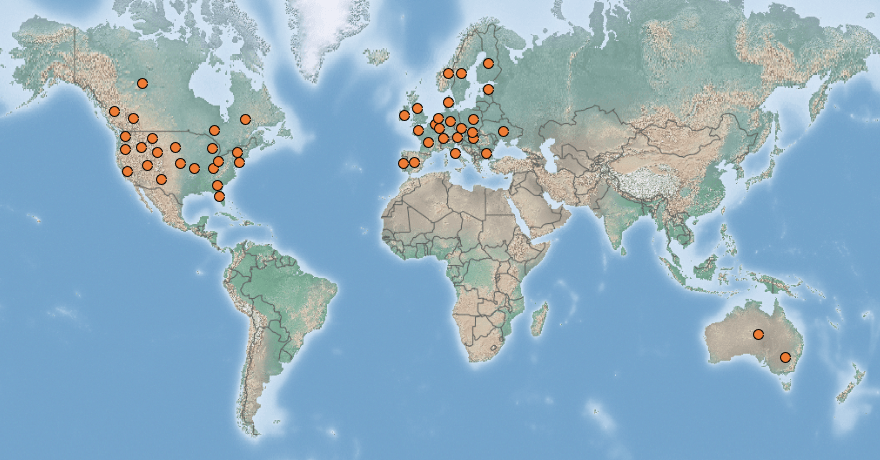 |
Oregon-grape | Status LU: established. 1st record: LU 1842, ITW <1875. |
 |
Gewéinlech Mahonie | Status Eur.: established. 1st record: 1822.1 |
 |
Mahonia faux houx | RA: ISEIA: B1 – Watch List. Harmonia+: 0,35. |
 |
Gewöhnliche Mahonie | Wikipedia:     | Wikispecies: | Wikispecies:  | CABI | CABI |
 |
Mahonie | Back to the list of neophytes |
Contents
Report the species
→ Report Mahonia aquifolium to the National Museum of Natural History.
Brief description

Mahonia aquifolium has a high growth rate due to hybridisation and subsequent selection by breeders. Rapid clonal growth takes place through root suckers and stem layering, leading to the formation of large and dense populations that are known to overgrow and outcompete native species and accelerate the colonisation of open habitats by woody vegetation (Branquart et al. 2010).
Status and distribution in Luxembourg
Records of Mahonia aquifolium (Pursh) Nutt. in Luxembourg. Data source: Recorder-Lux, iNaturalist & GBIF, 2025-06-30.
Mahonia aquifolium (Pursh) Nutt. is a common ornamental plant in Luxembourg which regularly escapes from cultivation in private and public gardens to form spontaneous woody vegetation. While documented occurrences in the wild remained rare until a few years ago the actual distribution map seems to indicate that uncultivated populations of the species are much more common now.
Koltz (1875:18) reports that the species was introduced into the Walferdange Park in 1842 (= 1st record); furthermore, it sometimes occurs subspontaneously, e.g. in the fir grove above the Jewish cemetery in Clausen (Luxembourg City), which is why we consider <1875 as the date of 1st record in the wild.
It was next documented in the wild in Luxembourg on 1950-07-20 by Léopold Reichling (1921-2009) in Verluerekascht (Municipality of Larochette) (MNHNL 2000-).
The oldest herbarium specimen at the MNHNL was collected by Jos. Witry on 1935-04-21 in a park in Bergem (Specimen № 51941, MNHNL 2000-).
The melliferous Oregon-grape originates from North America (Lambinon & Verloove 2012: 92).
Other Mahonia species, cultivars and hybrids
Various cultivars and hybrids of this species are planted for ornamental purposes, the latter resulting from hybridisation with other North American species Mahonia pinnata (Lag.) Fedde and M. repens (Lindl.) D. Don in particular. The following taxa could thus be observed escaping from culture: M. aquifolium, M. ×wagneri (Jouin) Rehd. (M. aquifolium × pinnata) and M. ×decumbens Stace (M. aquifolium × repens) (Lambinon & Verloove 2012: 92).
Krombach (1875: 38) mentions Mahonia repens (Lindl.) G.Don for Luxembourg: “Introduced from America and cultivated for its early flowering and evergreen foliage.”
In total, Jean-Pierre-Joseph Koltz (1875: 18) mentions six Mahonia species introduced to Luxembourg:
- Mahonia aquifolium (Pursh) Nutt.: introduced into the Walferdange Park in 1842;
- Mahonia fascicularis DC.: introduced into the Walferdange Park in 1842;
- Mahonia fortunei (Lindl.) Fedde: introduced into the Dominican Park in 1853;
- Mahonia japonica (Thunb.) DC.: introduced into the Dominican Park in 1854;
- Mahonia nervosa (Pursh) Nutt.: introduced into the Dominican Park in 1861;
- Mahonia repens (Lindl) G. Don: introduced into the Walferdange Park in 1842.
Risk assessment
ISEIA protocol
B1 (3+2+2+2) = Watch List (Ries et al. 2013: 18). Because of the growing number of documented observations the ISEIA evaluation should probably be changed to B2.
Harmonia+ protocol
Overall risk score 0,35 = (Overall Invasion score 0,72 x Overall Impact score 0,48) (Ries et al. 2020).
 Invasion
Invasion0,48

 Impact
Impact0,35

 Risk
RiskWorldwide distribution
Bibliography
- Branquart, E., S. Vanderhoeven, W. Van Landuyt, F. Van Rossum, F. Verloove & A. Vervoort, 2010. Harmonia database: Mahonia aquifolium (Pursh) Nutt.. Harmonia version 1.2, Belgian Forum on Invasive Species. URL: http://ias.biodiversity.be [accessed on 2019-10-11]
- CABI, 2021. Mahonia aquifolium. In: Invasive Species Compendium. Wallingford, UK: CAB International. URL: www.cabi.org/isc [accessed 2021-03-04]
- Koltz, J.-P.-J., 1875. Dendrologie luxembourgeoise. Catalogue des arbres, arbrisseaux et arbustes spontanés, subspontanés ou introduits dans la culture du Grand-Duché de Luxembourg. Imprimerie V. Buck, Luxembourg, 217 pp.
- Krombach, J.-H.-G., 1875. Flore du grand-duché de Luxembourg. Plantes phanérogames. 564 p. Luxembourg, Imprimerie Joris.
- Lambinon J. & F. Verloove, 2012. Nouvelle flore de la Belgique, du grand-duché de Luxembourg, du Nord de la France et des régions voisines. Sixième édition. Avec la collaboration de L. Delvosalle, B. Toussaint, D. Geerinck, I. Hoste, F. Van Rossum, B. Cornier, R. Schumacker, A. Vanderpoorten et H. Vannerom. Jardin botanique national de Belgique, Meise. CXXXIX + 1195 pp. ISBN : 9789072619884.
- MNHNL, 2000-. Mahonia aquifolium (Pursh) Nutt. in Recorder-Lux, database on the natural heritage of the Grand Duchy of Luxembourg. Musée national d’histoire naturelle, Luxembourg. URL: https://mdata.mnhn.lu [Accessed 2019-10-11]
- MNHNL, iNaturalist & GBIF, 2019. Mahonia aquifolium (Pursh) Nutt. in MNHNL-mdata, online portal combining species observation from Recorder-Lux, iNaturalist and GBIF. National Museum of Natural History, Luxembourg. URL: https://mdata.mnhn.lu [Accessed 2019-10-11]
- Ries, C. & Y. Krippel, 2021. First records of 56 invasive alien vascular plants in Luxembourg. Bulletin de la Société des naturalistes luxembourgeois 123: 115-127. [PDF 241 KB]
- Ries, C., Y. Krippel & M. Pfeiffenschneider, 2020. Risk assessment after the Harmonia+ protocol of invasive alien vascular plant species in Luxembourg. Bull. Soc. Nat. luxemb. 122: 197-205. [PDF 132 KB]
- Ries, C., Y. Krippel, M. Pfeiffenschneider & S. Schneider, 2013. Environmental impact assessment and black, watch and alert list classification after the ISEIA Protocol of non-native vascular plant species in Luxembourg. Bull. Soc. Nat. luxemb. 114: 15-21. [PDF 652 KB]
Suggested citation of this webpage
Ries, C., M. Pfeiffenschneider & Y. Krippel (Eds.), 2025. Mahonia aquifolium (Pursh) Nutt. In: neobiota.lu - Invasive Alien Species in Luxembourg. National Museum of Natural History, Luxembourg. URL: https://neobiota.lu/mahonia-aquifolium/ [Accessed 2025-06-30].
Page content last updated on 2023-05-05. Last proofread by Caroline Grounds on 2019-11-19.
- Cf. CABI 2021.[↩]


